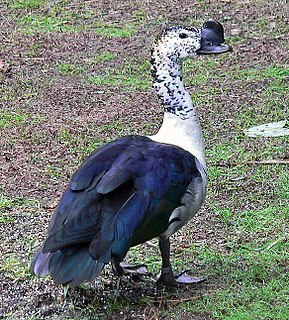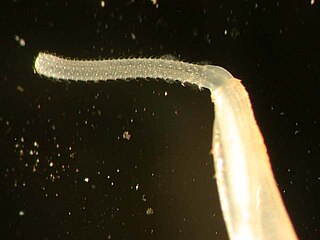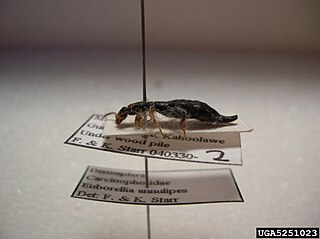
Sarkidiornis is sometimes considered a monotypic genus with its sole member the knob-billed duck, a cosmopolitan species. Most taxonomic authorities, however, split the species into two:

Ant spiders are members of the family Zodariidae. They are small to medium-sized eight-eyed spiders found in all tropical and subtropical regions of South America, Africa, Madagascar, Australia-New Guinea, New Zealand, Arabia and the Indian subcontinent. Most species are daytime hunters and live together with ants, mimicking their behavior and sometimes even their chemical traits. Although little is known about most zodariids, members of the genus Zodarion apparently feed only on ants; a number of other genera in the family are apparently also ant specialists.

Palaeacanthocephala is a class within the phylum Acanthocephala. The adults of these parasitic platyzoans feed mainly on fish, aquatic birds and mammals. This order is characterized by the presence of lateral longitudinal lacunar canals and a double-walled proboscis receptacle. The nuclei of the hypodermis are fragmented and the males have two to seven cement glands, unlike their relatives the Archiacanthocephala which always have eight.
Cyclostremellini is a minor tribe, a taxonomic grouping, of minute sea snails, marine gastropod mollusks or micromollusks, in the family Pyramidellidae, the pyrams and their allies.
Chapman's prehensile-tailed hutia or Gundlach's hutia is a subspecies of the prehensile-tailed hutia in the family Capromyidae. It is endemic to lowland moist forests on the island of Cuba. It is threatened by habitat loss.

Epomophorus is a genus of bat in the family Pteropodidae. They have a distribution throughout Africa.

Polymorphida are an order of thorny-headed worms. The adults of these parasitic platyzoans feed mainly on fish and aquatic birds.

Anisolabididae is a family of earwigs, in the suborder Forficulina and the order Dermaptera. It is one of nine families in the suborder Forficulina, and contains thirty-eight genera spread across thirteen subfamilies.

Myoleja is a genus of tephritid or fruit flies in the family Tephritidae.

Echinorhynchida is an order of parasitic worms in the phylum Acanthocephala. It contains the following families:

The Hemiphractidae are a family of frogs from South and Central America. Previously, this group had been classified as a subfamily (Hemiphractinae) under family Hylidae. More recent research classifies these genera into their own family, or sometimes into three separate families: Amphignathodontidae, Cryptobatrachidae, and Hemiphractidae (Hemiphractus). An active question still exists as to which of these groupings is more accurate.
The New Ireland forest rat is a large rodent in the family Muridae. It is endemic to New Ireland, in the Bismarck Archipelago, Papua New Guinea.

Episyron quinquenotatus, the white-trimmed black wasp, is a North American species of pompilid spider hunting wasp.

The Pompilinae are a subfamily of the spider wasp family, Pompilidae, the species of which lay their eggs on the paralysed bodies of their prey.

Dysdera erythrina is a species of spider in the family Dysderidae. It is nearly indistinguishable from the spider Dysdera crocata, but is far less common and has a much smaller geographic range. Like its relative D. crocata, this spider uses its disproportionately huge chelicerae to kill woodlice, as well as silverfish, earwigs, millipedes, beetles, and even centipedes.

Reticulariaceae is a family of slime molds recognized by the Integrated Taxonomic Information System and is composed of the genera Dictydiaethalium, Enteridium, Lycogala, Reticularia, and Tubifera.
Lasioglossum serenum, also known as the Lasioglossum (Nesohalictus) serenum, is a species of bee in the genus Lasioglossum, of the family Halictidae.

Mallinella is a genus of spider in the family Zodariidae.
Mallinella elegans is a species of spider in the family Zodariidae. It is found in Malaysia.

Notiosoricini, whose members are known as the North American gray shrews, is a tribe of shrews in the family Soricidae, including the genera Megasorex and Notiosorex. They are found across the southwestern United States and most of Mexico.














